LiFi Questions (FAQ)
Our list of most frequently asked LiFi questions
If you don’t see the answer to your LiFi question below use the form at the bottom to make a suggestion.
→ How does LiFi Work?
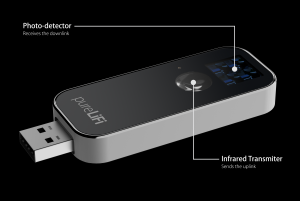
LiFi is high speed bidirectional networked and mobile communication of data using light. LiFi comprises of multiple light bulbs that form a wireless network.
When an electrical current is applied to a LED light bulb a stream of light (photons) is emitted from the bulb. LED bulbs are semiconductor devices, which means that the brightness of the light flowing through them can be changed at extremely high speeds. This allows us to send a signal by modulating the light at different rates. The signal can then be received by a detector which interprets the changes in light intensity (the signal) as data.
The intensity modulation cannot be seen by the human eye, and thus communication is just as seamless as other radio systems, allowing the users to be connected where there is LiFi enabled light. Using this technique, data can be transmitted from a LED light bulb at high speeds.
→ How much does LiFi cost?
pureLiFi is currently working towards miniaturisation of LiFi technology. Ultimately the end goal is to have LiFi in every mobile device. This means that the technology will be affordable for integration into handsets, tablets and laptops.
Ultimately the end consumer will see minimal or no cost associated with LiFi as the goal is to have LiFi embedded in every wireless mobile device.
Today companies can speak to pureLiFi about working with us on proof of concept projects and other types of installations. These installations are priced based on individual requirements.
Contact us
→ Can we see LiFi lights flicker?
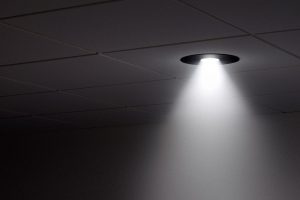 The LED lights used to transmit LiFi signals are modulated at such a fast rate that the eye cannot perceive the modulation or “flicker”. This is similar to the way our eyes do not interpret the break between film frames in a motion picture. Just as you see a smooth motion on the cinema screen, you will see an uninterrupted source of steady light streaming from a LiFi enabled luminaire.
The LED lights used to transmit LiFi signals are modulated at such a fast rate that the eye cannot perceive the modulation or “flicker”. This is similar to the way our eyes do not interpret the break between film frames in a motion picture. Just as you see a smooth motion on the cinema screen, you will see an uninterrupted source of steady light streaming from a LiFi enabled luminaire.As a comparison, the lowest frequency at which the lights are modulated is 1MHz and this is 10,000 times higher than the refresh rate of our computer screens.
→ How does LiFi work in a bright room with sunlight?
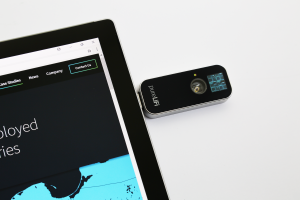 LiFi can operate in daylight and even in direct sunlight conditions, as the modulated light can still be detected. LiFi
LiFi can operate in daylight and even in direct sunlight conditions, as the modulated light can still be detected. LiFirelies on detecting the fast changes in light intensity and not on the absolute or slowly varying levels caused by natural disruptions in daylight or sunlight. LiFi technology modulates the light at very high rates and sunlight is constant light and therefore can be filtered out at the receiver.
Our team at pureLiFi has tested our receivers outdoors under 77,000 Lux of sunlight.
→ How does LiFi work when you turn off the lights?
If all power to a light is turned off then there is no LiFi. However, LiFi technology can be enabled to dim low enough that a room will appear dark and still transmit data. There is consistent performance between 10 and 90 percent illumination.
Currently, pureLiFi’s technology provide communications at light levels down to 60 lux. For comparison the British standard for minimum light level for reading is 400 lux.
There are also other options for using invisible parts of the light spectrum such as infra-red, which is currently already being used for sending information back to the lightbulb (uplink).
→ Will LiFi work in my pocket?
No LiFi does not work in your pocket, unless you have a transparent suit.
LiFi is a complimentary technology that works alongside other wireless technologies such as Wi-Fi. If the light signal to a LiFi enabled device is below the receiver’s threshold then it will not receive data. In that instance, radio systems or cellular networks, if available, will continue to deliver data.
However, the moment the device begins to receive light from a LiFi light bulb, then the device will resume high speed communications using light as an additional communications medium.
→ Is LiFi a line of sight technology?
Light bounces off of surfaces and therefore LiFi is not strictly a line-of-sight technology.
LiFi is a cellular communication system and the data rate is not dependent on the line of sight but on the signal quality at the device. Signal quality can be defined by the ratio of the desired data vs any interfering data and noise.
→ How is LiFi more secure than other wireless technologies?
pureLiFi is developing the security components and technologies that enable security specialists to deliver more secure wireless communications.
LiFi is significantly more secure than other wireless technologies because light can be contained in a physical space. Our doors and windows can be shut, and physical barriers and adjustments can be implemented to contain and protect the light. We can create the conditions that allow us to shut the door on our wireless data.
It should be understood that the existing security protocols for encryption and authentication can be leveraged in LiFi systems to provide even more secure wireless systems.
→ Is LiFi a bidirectional technology, and what does that mean?
LiFi is bidirectional wireless communications technology that allow high speed transmission in both uplink and downlink simultaneously.
→ How does the backhaul work?
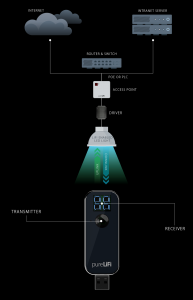
There are two solutions for providing backhaul for LiFi wireless communications.
Currently, power over Ethernet (POE) is the optimal solution for driving the network backhaul and therefore the preferred option for new installations. Power line communications (PLC) is the preferred option for retrofit installations. PLC can be used for by sharing the available capacity between lamps attached to any given ring main.
The long-term backhaul is resolved by using Power over Ethernet in new offices, which is proving more efficient for smart buildings and lighting. An example is the Edge Building in Amsterdam that is the current headquarters of Deloitte. The building has over 6,000 PoE connected lighting fixtures, which resulted in a 50% reduction in installation time as well as a 25% installation cost saving. This is the future.
Enabled by pureLiFi technology, the “Cloud RAN” architecture can also help alleviate the pressure on the backhaul.
→ What is uplink?
Uplink is when information is sent back from the client (user device) This enables bi-directional LiFi communication which is key to enabling a truly wireless internet browsing experience.
pureLiFi uses invisible parts of the light spectrum to perform uplink called infra-red (IR).
→ What is Data Density?
Data density is the wireless capacity available in a particular area and is important because it directly affects the quality of service (QoS) achievable for each user.
Data densities offered by LiFi allows for significantly greater capacity. For example in a room with 6 LiFi integrated lights, each light transmits 42 Mbps leading to a total capacity of 252 Mbps in that room. This results in a reliable and faster user experience.
